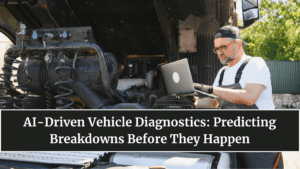Imagine if your car could tell you it’s about to break down — days before it actually does. In 2025, that’s not science fiction; it’s the reality of AI-driven vehicle diagnostics. As vehicles become smarter and more connected, artificial intelligence is transforming maintenance into a proactive, predictive system. Instead of waiting for a warning light or a mechanical failure, AI now identifies problems early, often before the driver even notices them.
This technology is rapidly becoming a standard feature in both electric and traditional vehicles, reshaping how manufacturers, fleet operators, and everyday drivers approach vehicle care and safety.

The Evolution of Vehicle Diagnostics
Traditional car diagnostics relied heavily on OBD (On-Board Diagnostics) systems — reactive tools that alerted drivers only after a fault occurred. But with the integration of machine learning, IoT sensors, and real-time analytics, diagnostics have shifted from reactive to predictive.
Now, AI models analyze millions of data points — from engine vibrations and battery temperature to driving habits and environmental conditions — to detect anomalies long before they escalate into serious problems.
How AI Vehicle Diagnostics Work
AI-driven systems use a combination of sensor networks, cloud computing, and edge analytics to continuously monitor a vehicle’s condition. Here’s how the process works:
-
Data Collection: Sensors capture data from all major components — engine, brakes, battery, tires, and electronics.
-
AI Analysis: Machine learning algorithms process this data to detect abnormal patterns.
-
Prediction: If a fault trend is detected, the system predicts when and where a component might fail.
-
Notification: The driver receives early alerts with recommended actions, such as scheduling maintenance or replacing a part.
This integration allows vehicles to effectively “self-diagnose,” minimizing unplanned breakdowns and optimizing service schedules.
Key Benefits for Drivers and Fleets
The advantages of AI diagnostics go beyond convenience — they’re transforming the economics of vehicle ownership and fleet management.
-
Preventive Maintenance: Early detection means fewer major repairs and longer vehicle lifespans.
-
Cost Savings: Reduces overall maintenance expenses by up to 30%.
-
Safety Enhancement: Prevents accidents caused by component failures such as brake or engine malfunctions.
-
Downtime Reduction: Fleet vehicles can stay on the road longer, improving operational efficiency.
-
Environmental Benefits: Efficient maintenance reduces fuel consumption and emissions.
For large fleets — such as delivery vans, buses, and logistics vehicles — this technology translates directly into higher profitability and sustainability.
Examples of AI Diagnostic Technology in Action
Many automakers and tech firms have already integrated AI diagnostics into their 2025 models.
-
Tesla uses predictive algorithms to anticipate battery degradation and motor efficiency loss.
-
BMW’s ConnectedDrive monitors component wear in real time and auto-schedules service appointments.
-
Toyota’s Intelligent Maintenance System tracks hybrid system health and predicts energy efficiency drops.
-
Startups like Uptake and Nauto are developing predictive analytics platforms for commercial fleets.
These innovations ensure vehicles remain safe, efficient, and ready for the road — without the surprise of sudden repairs.
The Role of Predictive Maintenance in EVs
Electric vehicles stand to gain the most from AI diagnostics. EVs depend on complex systems such as battery management, regenerative braking, and electric drive motors, all of which benefit from continuous monitoring.
AI tools can:
-
Detect early battery cell imbalances before capacity loss.
-
Predict charging system degradation due to heat or voltage fluctuations.
-
Optimize energy consumption patterns to extend range.
With battery replacement costs remaining high, predictive AI maintenance can save EV owners thousands of rupees or dollars over a vehicle’s lifetime.
Challenges and Future Outlook
Despite its potential, AI diagnostics faces a few challenges:
-
Data Privacy: Connected vehicles generate vast amounts of sensitive user data that must be secured.
-
Standardization Issues: Different manufacturers use incompatible diagnostic frameworks.
-
Cost of Integration: Adding advanced AI hardware increases production costs.
-
Dependence on Connectivity: Remote areas with poor networks limit cloud data analysis efficiency.
However, these challenges are being addressed as edge computing and blockchain-based data security evolve. By 2030, nearly all new vehicles — especially EVs — will feature built-in AI diagnostic systems capable of self-learning and self-healing.
The Road Ahead: From Maintenance to Intelligence
AI-driven vehicle diagnostics mark a paradigm shift from mechanical maintenance to intelligent mobility. Future systems will not only identify issues but automatically communicate with service centers, order parts, and schedule repairs — all without driver intervention.
In the near future, your car won’t just transport you; it will act as a digital guardian, ensuring optimal performance, safety, and reliability throughout its lifecycle.
FAQs
What is AI-driven vehicle diagnostics?
It’s a technology that uses artificial intelligence and sensors to predict mechanical issues before they happen, allowing preventive maintenance.
How does AI help prevent breakdowns?
AI continuously analyzes real-time data from various vehicle systems to identify patterns that indicate potential problems.
Is AI diagnostics available for all cars?
While most new models include it, aftermarket OBD devices and apps now bring similar AI features to older vehicles.
Do electric vehicles benefit more from AI diagnostics?
Yes. Since EVs rely on complex battery systems, predictive diagnostics help extend battery life and ensure consistent performance.
What’s next for vehicle diagnostics?
By 2030, fully autonomous diagnostic systems will connect directly to repair centers, creating a seamless, self-maintaining vehicle ecosystem.
Click here to know more.
